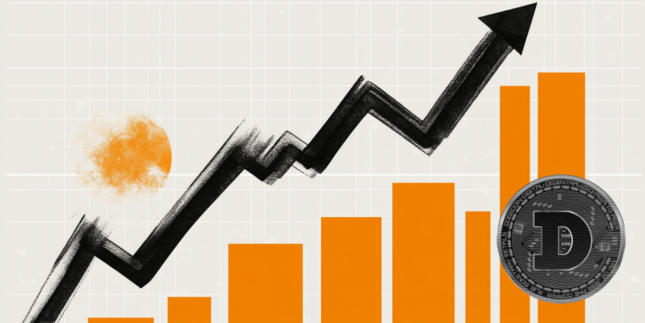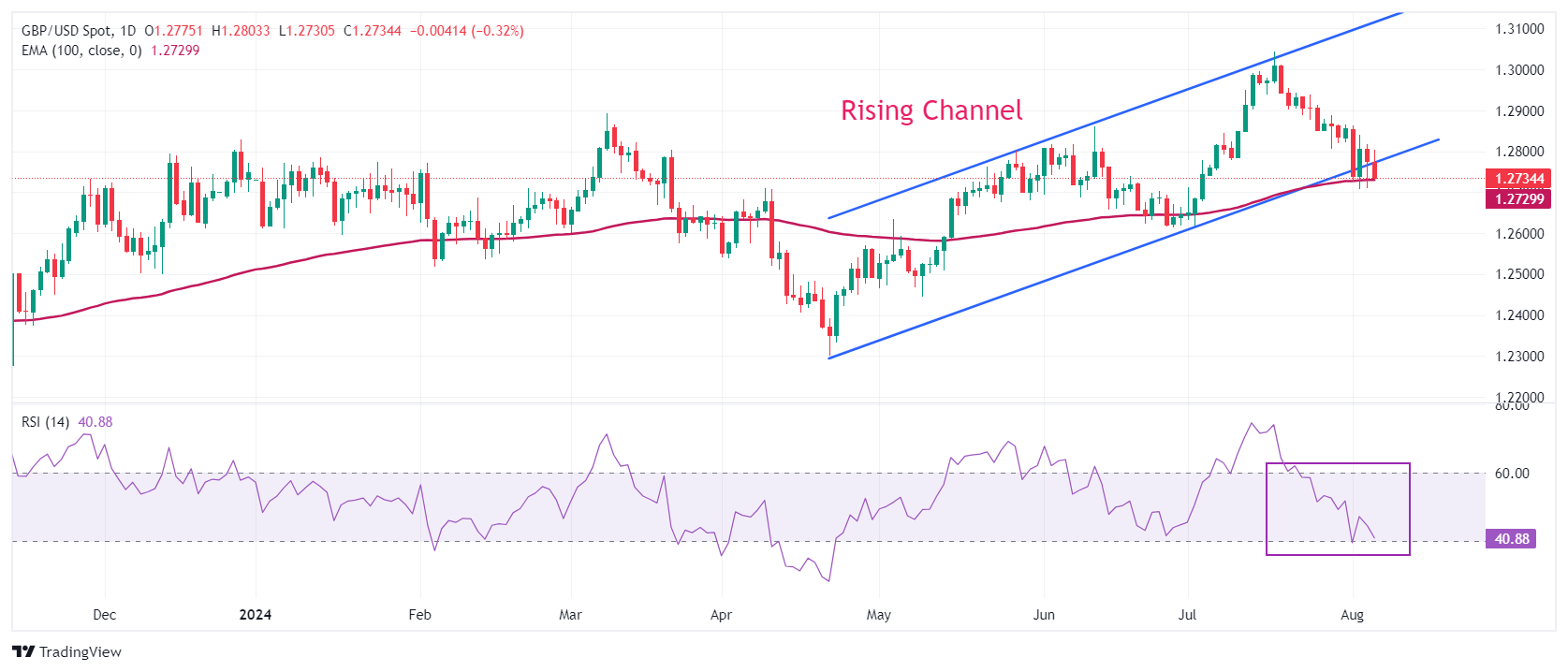- The Pound Sterling falls against the US Dollar below 1.2700 amid weak appeal for risk-sensitive currencies.
- Investors worry that the US economy could enter a recession.
- The British currency will be guided by market speculation for BoE rate cuts.
The Pound Sterling (GBP) extends its downside below 1.2700 against the US Dollar (USD) in Tuesday’s New York session. The GBP/USD pair weakens as the US Dollar steadies after rebounding from fresh six-month low. The US Dollar Index (DXY), which tracks the greenback’s value against six major currencies, recovers to near 103.00.
The outlook for the US Dollar remains vulnerable as market participants worry about growing speculation of a recession in the United States (US) and an announcement of emergency rate cuts by the Federal Reserve (Fed).
Market expectations of potential US recession grew after a string of weak US economic data. The Unemployment Rate rose to 4.3%, the highest since November 2021, labor demand slowed, and the Manufacturing Purchasing Managers Index (PMI) contracted at a faster pace in July. However, an economy is considered in a technical recession if its Gross Domestic Product (GDP) contracts consecutively for two quarters, which appears the opposite in the US’s case, knowing that the economy expanded at a pace of 2.8% on an annualized basis in the second quarter. The pace at which the US economy grew was double the growth rate recorded for the January-March period.
Also, the US Services PMI, a sector that accounts for two-thirds of the economy, expanded at a faster pace in July after contracting in June. The PMI report showed that activities in the service sector expanded at a faster-than-expected pace of 51.4. Investors anticipated a growth in the Services PMI to 51.0 from the former release of 48.8.
Daily digest market movers: Pound Sterling remains on backfoot against US Dollar
- The Pound Sterling remains on the back foot against its major peers but performs strongly against the Japanese Yen (JPY) and the Swiss Franc (CHF), as both faced profit-booking on Tuesday. The British currency continues to face pressure from widespread risk aversion.
- Apart from fears of a US slowdown, a likely all-out war between Israel and Iran has also kept risk sentiment on tenterhooks. Fears of escalating Middle East conflicts were prompted after Iran-backed Hezbollah said it launched dozens of missiles on Israel on Saturday in retaliation to the assassination of Hamas leader Ismail Haniyeh by an Israeli airstrike in Tehran.
- On the domestic front, the Pound Sterling will be guided by market speculation for the Bank of England (BoE) amid an absence of top-tier events. Market participants expect that the BoE could also deliver subsequent rate cuts to fight against the ripple effects of the US slowdown.
- Last week, the BoE cut interest rates by 25 basis points (bps) to 5%, with a 5-4 vote split, as expected. The BoE suggested that the central bank will use a cautious approach in its policy normalization process.
Pound Sterling Price Today:
British Pound PRICE Today
The table below shows the percentage change of British Pound (GBP) against listed major currencies today. British Pound was the strongest against the Japanese Yen.
| GBP | EUR | USD | JPY | CAD | AUD | NZD | CHF | |
|---|---|---|---|---|---|---|---|---|
| GBP | -0.20% | -0.58% | -0.02% | -0.46% | -0.35% | -0.24% | -0.29% | |
| EUR | 0.20% | -0.38% | 0.16% | -0.28% | -0.16% | -0.06% | -0.04% | |
| USD | 0.58% | 0.38% | 0.55% | 0.12% | 0.24% | 0.40% | 0.33% | |
| JPY | 0.02% | -0.16% | -0.55% | -0.44% | -0.30% | -0.22% | -0.08% | |
| CAD | 0.46% | 0.28% | -0.12% | 0.44% | 0.12% | 0.23% | 0.18% | |
| AUD | 0.35% | 0.16% | -0.24% | 0.30% | -0.12% | 0.12% | 0.08% | |
| NZD | 0.24% | 0.06% | -0.40% | 0.22% | -0.23% | -0.12% | 0.00% | |
| CHF | 0.29% | 0.04% | -0.33% | 0.08% | -0.18% | -0.08% | -0.01% |
The heat map shows percentage changes of major currencies against each other. The base currency is picked from the left column, while the quote currency is picked from the top row. For example, if you pick the British Pound from the left column and move along the horizontal line to the US Dollar, the percentage change displayed in the box will represent GBP (base)/USD (quote).
Technical Analysis: Pound Sterling drops to near 1.2700
The Pound Sterling is at a make-or-break near the lower boundary of a Rising Channel chart formation on a daily timeframe. Historically, a pullback move in the aforementioned chart pattern is considered a buying opportunity by market participants.
The GBP/USD pair fell on the back foot after breaking below the crucial support of 1.2900. The Cable is an inch away from the 50-day Exponential Moving Average (EMA) near 1.2790, suggesting uncertainty in the near-term trend.
The 14-day Relative Strength Index (RSI) declines to near 40.00, which is expected to act as a cushion for the momentum oscillator.
On the downside, the round level of 1.2800 will be a crucial support zone for the Pound Sterling bulls. Meanwhile, the two-year high near 1.3140 will be a key resistance zone for the Cable.
Risk sentiment FAQs
In the world of financial jargon the two widely used terms “risk-on” and “risk off'' refer to the level of risk that investors are willing to stomach during the period referenced. In a “risk-on” market, investors are optimistic about the future and more willing to buy risky assets. In a “risk-off” market investors start to ‘play it safe’ because they are worried about the future, and therefore buy less risky assets that are more certain of bringing a return, even if it is relatively modest.
Typically, during periods of “risk-on”, stock markets will rise, most commodities – except Gold – will also gain in value, since they benefit from a positive growth outlook. The currencies of nations that are heavy commodity exporters strengthen because of increased demand, and Cryptocurrencies rise. In a “risk-off” market, Bonds go up – especially major government Bonds – Gold shines, and safe-haven currencies such as the Japanese Yen, Swiss Franc and US Dollar all benefit.
The Australian Dollar (AUD), the Canadian Dollar (CAD), the New Zealand Dollar (NZD) and minor FX like the Ruble (RUB) and the South African Rand (ZAR), all tend to rise in markets that are “risk-on”. This is because the economies of these currencies are heavily reliant on commodity exports for growth, and commodities tend to rise in price during risk-on periods. This is because investors foresee greater demand for raw materials in the future due to heightened economic activity.
The major currencies that tend to rise during periods of “risk-off” are the US Dollar (USD), the Japanese Yen (JPY) and the Swiss Franc (CHF). The US Dollar, because it is the world’s reserve currency, and because in times of crisis investors buy US government debt, which is seen as safe because the largest economy in the world is unlikely to default. The Yen, from increased demand for Japanese government bonds, because a high proportion are held by domestic investors who are unlikely to dump them – even in a crisis. The Swiss Franc, because strict Swiss banking laws offer investors enhanced capital protection.
Information on these pages contains forward-looking statements that involve risks and uncertainties. Markets and instruments profiled on this page are for informational purposes only and should not in any way come across as a recommendation to buy or sell in these assets. You should do your own thorough research before making any investment decisions. FXStreet does not in any way guarantee that this information is free from mistakes, errors, or material misstatements. It also does not guarantee that this information is of a timely nature. Investing in Open Markets involves a great deal of risk, including the loss of all or a portion of your investment, as well as emotional distress. All risks, losses and costs associated with investing, including total loss of principal, are your responsibility. The views and opinions expressed in this article are those of the authors and do not necessarily reflect the official policy or position of FXStreet nor its advertisers. The author will not be held responsible for information that is found at the end of links posted on this page.
If not otherwise explicitly mentioned in the body of the article, at the time of writing, the author has no position in any stock mentioned in this article and no business relationship with any company mentioned. The author has not received compensation for writing this article, other than from FXStreet.
FXStreet and the author do not provide personalized recommendations. The author makes no representations as to the accuracy, completeness, or suitability of this information. FXStreet and the author will not be liable for any errors, omissions or any losses, injuries or damages arising from this information and its display or use. Errors and omissions excepted.
The author and FXStreet are not registered investment advisors and nothing in this article is intended to be investment advice.
Recommended content
Editors’ Picks

EUR/USD bounces off 1.1300 neighborhood; shows resilience below 23.6% Fibo.
EUR/USD drifts lower for the second straight day amid a further USD recovery from a multi-year low. The technical setup favors bulls and warrants caution before positioning for a deeper corrective fall. A sustained break and acceptance below 1.1300 could pave the way for some meaningful decline.

GBP/USD weakens below 1.3300 as US Dollar rises
GBP/USD extended its losses during Wednesday’s Asian session, trading around 1.3300 after pulling back from a seven-month high of 1.3424 recorded in the previous session. The pair weakened as investor appetite shifted back toward US assets, including the US Dollar, buoyed by a more optimistic tone from US President Donald Trump.

Gold price sticks to intraday losses amid positive risk tone; still holds comfortably above $3,300
Gold price moves away from the all-time peak touched on Tuesday amid receding safe-haven demand. Easing US-China tensions remains supportive of the risk-on impulse and weighs on the XAU/USD pair. The downside for the commodity seems limited as the USD bulls seem reluctant amid Fed rate cut bets.

Dogecoin lead double-digit gains across meme coins, with Shiba Inu, PEPE and BONK skyrocketing to new monthly highs
Top meme coins Dogecoin, Shiba Inu, PEPE and BONK lead the meme coin sector with double-digit gains on Wednesday following the crypto market recovery.

Five fundamentals for the week: Traders confront the trade war, important surveys, key Fed speech Premium
Will the US strike a trade deal with Japan? That would be positive progress. However, recent developments are not that positive, and there's only one certainty: headlines will dominate markets. Fresh US economic data is also of interest.

The Best brokers to trade EUR/USD
SPONSORED Discover the top brokers for trading EUR/USD in 2025. Our list features brokers with competitive spreads, fast execution, and powerful platforms. Whether you're a beginner or an expert, find the right partner to navigate the dynamic Forex market.




